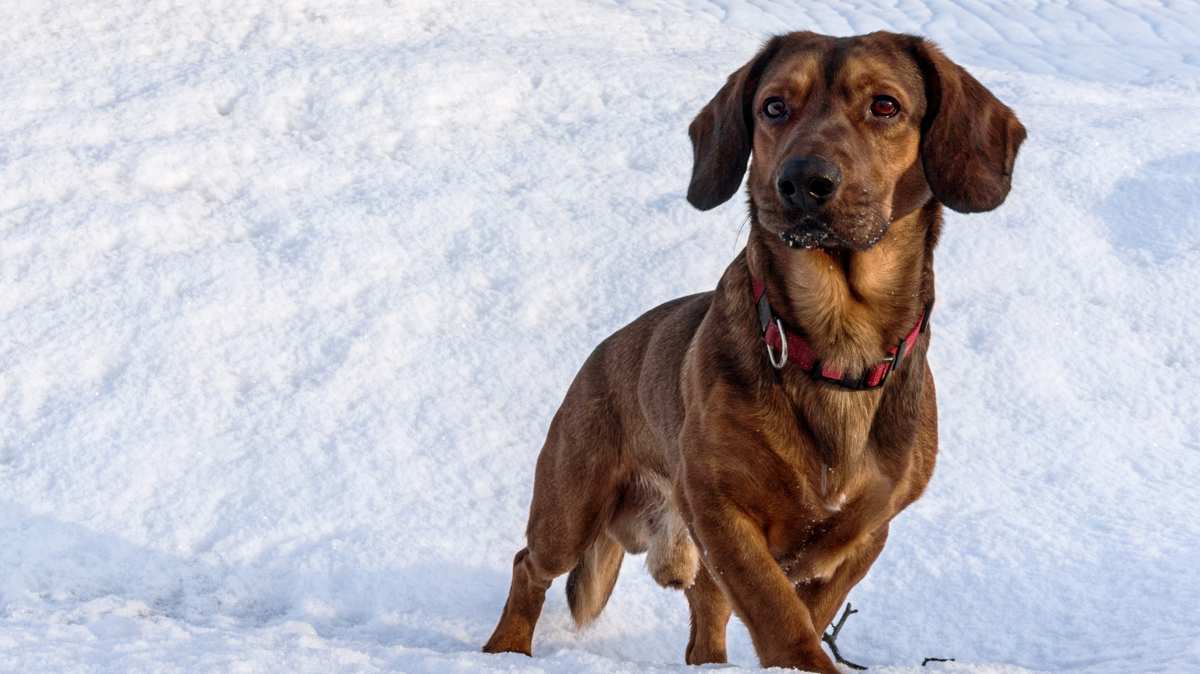Alpine Dachsbracke Breed Details
Below are breed specs and details for the Alpine Dachsbracke.

The Alpine Dachsbracke, or Alpenlandischer Dachsbracke as it is called in Austria, was bred for hunting and tracking wounded prey such as hares and foxes. Although it is a hunting breed these are typically not aggressive dogs and instead are loyal, friendly and intelligent. The short coat makes them low maintenance as far as grooming, but they are naturally active and require daily walks.
Dachsbrackes are loyal dogs, will make good companions but are not necessarily family dogs or watchdogs. They can live in apartments as long as they receive enough exercise to burn off their energy. The Alpine Dachsbracke makes a good outdoor dog as long as the temperature is not too hot. This breed has no major health issues and has an expected lifespan of 12 years.
Below are breed specs and details for the Alpine Dachsbracke.
The Alpine Dachsbracke is a medium size dog reaching 13-16 inches from ground to shoulder. They weigh between 33-40 pounds and are considered to be muscular and sturdy dogs.
This dog is still a dog owned for hunting and tracking purposes and therefore is not as popular with families. However, owners looking for a companion will be pleased with its loyalty and ease of training. This dog is non-aggressive and does well with children. They coexist well with other dogs but may have hunting and chasing tendencies with small pets. Members of this breed are somewhat friendly with strangers and do not make good guard dogs.
These are low maintenance and low grooming dogs. The coat is short and sheds little. A weekly brushing along with an ear and mouth check should suffice. Long daily walks are desirable as this breed has a high natural stamina and endurance.
The Alpine Dachsbracke originated around the mid 1800s when local Alpine Bracke hounds were crossed with Dachsunds from Germany. The breed was said to be established by 1881 and recognized in Austria by 1935. However, it was not recognized as a scent hound by the FCI (Federation Cynologique Internationale) until 1991, although they had recognized the breed's origination as Austria in 1975, and the UKC (United Kennel Club) soon after.As this breed originated in Austria, it was very popular with Austrian as well as German royalty. Prince Rudolf of Habsburg, crowned Austrian Prince in 1880s, brought them along on his hunting trips to Egypt and Turkey.
Members of this breed are of greater size than other Dachsund like dogs since they were bred with larger Alpine dogs. They are long and sturdy with strong shoulders, a thick neck and tail. The head is slightly arched with a highly positioned, straight nose. The legs are still short, however, this allows the breed to more accurately pick up scent during hunting. The Alpine Dachsbracke has a double layer coat consisting of a thick topcoat and dense undercoat. This coat is short everywhere but the neck and tail. Red, brown and black are the typical coat colors and some may have a white star on the chest.
As a dog bred for courage, endurance, and power Dachsbrackes will need owners that make themselves the clear pack leader. Although they are of a hunting breed, they are typically non-aggressive; they are prized in hunting because they are able to retrieve the owner's kill without causing any further damage to the hide or meat of the game animal.
These dogs are sociable but can become shy sometimes. They are easily trained as long as they trust the trainer and respond best with gentle positive reinforcement.
Members of this breed are low maintenance and easy to train. Long daily walks are recommended for them. The coat is short and requires only weekly brushing.
The hair is smooth and short so only weekly brushing is recommended. It is unlikely this breed will need regular bathing. The ears and teeth should be checked weekly and cleaned if needed. The nails should be monitored for trimming.
Dachsbrackes are hunting dogs and bred for stamina and endurance. They will need plenty of exercise; long daily walks (not runs) are recommended. Don't expect this dog to keep up with you on your daily run, although it requires plenty of exercise its legs are short which makes it slow-moving and difficult to keep a high running pace. These pets would really enjoy mock-hunting exercise.
Due to the amount of exercise this breed requires it makes a fine outdoor dog as long as the temperature is cool. Apartments (with AC in warm-hot areas) are fine and indoor pets will need daily exercise outdoors. If the living area is warm, it is advisable to exercise them early morning or late evening.
The life expectancy of the Alpine Dachsbracke is around 12 years. No major health issues have been documented in this breed, so they will likely live a full, healthy life. The few minor reported issues include patellar luxation, disk degeneration, and possible ear and teeth issues if not appropriately maintained. In the case your pet needs surgery he/she may be sensitive to anesthesia.
Below are common health issues associated with the breed:
Below are potential health concerns associated with Alpine Dachsbrackes.